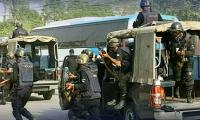I recently met a student of mine who is from Fata. He was awarded a scholarship by the HEC that was abruptly discontinued this semester due to budget cuts. Forced to freeze his semester, he is now desperately looking for jobs in Lahore.
So many bright and enthusiastic students having to fight for survival rather than pursue their education is reason enough for all of us to feel a sense of collective shame.
Yet, his story or the stories of countless other students struggle to make it to the headlines. The neglect and abandonment experienced by our young citizens has resulted in a deep sickness brewing in our society. The fact that we remain more interested in amplifying charades of conquest and heroism by politicians rather than debating the causes of our accelerating decline points to a larger crisis in which words and images circulating in the media no longer correspond to popular aspirations
One of the clearest examples of this breach between the language of high politics and the social crisis we face is the abysmal situation of students in our higher education. This past week a number of disturbing events surfaced, revealing the scale of the crisis. Unfortunately, neither the government (claiming to be representatives of the youth) nor the opposition (planning to overthrow the government) has tried to connect to the social struggles erupting on campuses across the country.
Let us quickly recap some of the major eruptions that should be cause for concern. A week ago, Amir Baloch, a Baloch student at the Punjab University, was beaten up by members of the Islami Jamiat Tuleba (IJT). While student groups are ostensibly banned on campus, the IJT is tolerated by the university administration and is often used to attack dissenting students, playing the role of an undeclared policeman. In another instance, at Quaid-e-Azam University, MPhil and PhD scholars began protesting after the abrupt declaration that they would no longer have access to hostels.
For days, these scholars have been camping outside the vice chancellor’s office, demanding that the university allot them an affordable place to stay. At a time when they ought to be engaging with innovative ideas, they are forced into a struggle over their right to dwelling. Their situation is similar to students of Edwards College Peshawar who have protested relentlessly over the past few months against an unprecedented fee hike and inadequate teaching facilities. Their desperate pleas remain unanswered.
Another harrowing story came from Bahria University Lahore, where a student died after falling from a building. Protests by students led to the revelation that the building was under construction and was unfit for public use. The incident happened only a week after the heartbreaking story of Nimrata Chandani, a medical student at Bibi Asifa Dental College Larkana who was found dead in her hostel room. Attempts by the police to cover up the incident as suicide ignited protests from students across Sindh, leading to a judicial inquiry. Such tales signal the subterranean fear of violence that haunts campuses, a form of vulnerability exposed most spectacularly in the lynching of Mashal Khan.
Finally, a number of students in Hyderabad organized a mass rally to demand the restoration of student unions. Hundreds of students from various ethnic backgrounds and different universities participated in the unprecedented protests. Yet, the response of the government was to immediately launch a crackdown against the organizers. Hamza Chandio and Kashif Bhutto, two of the main organizers, were detained for two days without any charges. This episode shows that despite all rhetoric about “youth empowerment”, students primarily remain a law and order problem for the coercive apparatuses of the state. In particular, a student who uses her/his education to question the structures of power is immediately viewed as suspect, rather than being treated as a well-informed citizen.
The policing of dissent very quickly descends into old fashioned anxiety over the ‘moral values’ of the youth. The recurrent news of gender segregation from Khyber Pakhtunkhwa or Lahore’s University of Engineering and Technology as well as calls to ban social media on campus are good examples of the moral policing that is substituting critical thinking on campuses. Since there is no way for students to hold university administrations accountable, the latter resort to manipulating public opinion on sensitive topics such as blasphemy, national security and gender-mixing to cover up their own inadequacies while blaming students for excessive irreverence.
This toxic anxiety is rearing its head at a time when the state is abdicating its responsibility in a striking manner. Under the IMF’s conditionalities, the government has slashed higher education budget from Rs45 billion to Rs30 billion, prompting the HEC chairman to advise public universities to “raise their own funds”. This of course means increasing tuition fees as well as cutting funding for teachers and infrastructure development on campuses. In Sindh, public-sector universities have begun borrowing from commercial banks to pay for their administrative costs, an amount that will eventually be extracted from the students. What we are witnessing is the unravelling of the very idea of a public good as quality education is relegated to a consumer good available only to those who can afford it.
All of these tales point to the paradoxical role played by the youth in national discourse. ‘Youth’ is a category that must be excessively invoked by every party to proclaim a legitimate vision for the future. At the same time, the youth also denotes a possibility beyond the confines of the present, which can rupture the logic of the status quo. The subversive potential of the youth induces the need for containment at the hands of the authorities, lest the contagion spread beyond a point of no return.
This latter tendency is fuelling the fear around students. The ruling party built its image around its commitments to the youth, but is unwilling to provide any representation to students. Even the opposition that claims to fight for democracy is unwilling to make campus democracy a central pillar of its campaign. Empowering students is a risk no political entity is willing to undertake.
The crisis that young people face is dire, and the funding cuts make it only worse. Unless a serious effort is made to address the contradictions accumulating in higher education, we will continue to let down our young citizens, annihilating our own future in the process. Perhaps the only effective way to fix the problem is to make students real stakeholders on campuses, a role denied to them as a result of the ban on student unions. Otherwise, the accumulating rage among the youth will not adhere to the ‘national agenda’ of politics and will continue to force its way onto the mainstream.
Pakistani students already displayed their capacity to lead when last week they joined their counterparts across the world to mobilize for the climate march across the country. No political party supported these mobilizations, which attracted hundreds of young people demanding a just and liveable future. Similarly, hundreds of students belonging to disparate ethnic backgrounds at Punjab University galvanized against the high-handedness of the IJT to stand in solidarity with the Baloch students, melting away decades of fear.
These are signs that the policy of silencing young people is no longer working. These examples demonstrate that students today embody the new world that is slowly emerging out of the rabble of a decaying status quo. Rather than being afraid, we must find the courage to embrace this opportunity.
The writer is an historian and a member of the Haqooq-e-Khalq Movement.
Email: ammarjan86@gmail.com
A view of the Supreme Court of Pakistan. — Supreme Court website/FileWhat kind of firewall does the judiciary...
Indian soldiers stand alongside a barbed wire on the Line of Control. — AFP/FileAnti-Pakistan propaganda remains a...
A representational image showing farmers harvesting wheat crops in a field. — AFP/FileThere is a clear, lasting, and...
Pakistan's first president Major General Iskander Mirza while speaking with the Turkish Prime Minister Adnan...
Prime Minister Shehbaz Sharif pictured alongside President Asif Ali Zardari. — INP/FileBeing a man of action in...
A worker fixes a flag of the ruling Bharatiya Janata Party on a hoarding of their leader and India’s Prime Minister...







